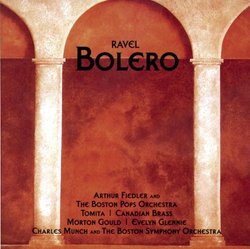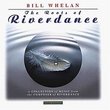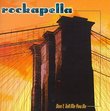| All Artists: Maurice Ravel, Arthur Fiedler, Charles Münch, Eduardo Mata, Sergey Koussevitzky, Boston Pops Orchestra, Boston Symphony Orchestra, Dallas Symphony Orchestra, Jacques Fray, Mario Braggiotti, Morton Gould Title: Ravel: Bol�ro Members Wishing: 0 Total Copies: 0 Label: RCA Release Date: 6/6/2000 Genre: Classical Styles: Historical Periods, Modern, 20th, & 21st Century, Symphonies Number of Discs: 1 SwapaCD Credits: 1 UPC: 090266367023 |
Search - Maurice Ravel, Arthur Fiedler, Charles Münch :: Ravel: Bol�ro
 | Maurice Ravel, Arthur Fiedler, Charles Münch Ravel: Bol�ro Genre: Classical
|
Larger Image |
CD DetailsSimilarly Requested CDs
|
CD ReviewsBolero-MADNESS! 05/16/2001 (4 out of 5 stars) "This is one fantastic CD!!!!Ten versions of Maurice Ravel's masterpiece "Bolero". You may ask yourself, "Isn't it repeatitive as much as it is?". That may be true, but this CD won't make you think about how repeatitive it is, it's that great. But do they all sound the same???Not exactly, Charles Munch and the Boston Symphony Orchestra play it about dancing speed. The total time is 13:48, compared to its original approx. of 15 minutes. So this version of the full orchestra is slightly faster than one thinks. Isao Tomita on the synthesizer sounds well...different. People may think it will be great because of the glamour of it being a synthesizer, but it's not as great you would think. If you're a fan of Bolero's monster conclusion, this is an extreme dissapointment because the performer does weird things with the synthesizer that make the work (in my opinion) sound like Ravel himself would hate hearing it. But you may like it, thats just my opinion. Jacques Fray & Mario Braggiotti on two pianos, despite the poor recording quaility since it is from 1934 is pretty good. This is probably one of the better interpretations on the disc. The performers add a little harmony into some of the melody's chords, which I think people will like. Serge Koussevitzky and the Boston Symphony Orchestra.....ouch! This is probably the worst recording quality on the whole disc! (It was recorded in 1930) To me, the conclusion doesn't sound "extreme" enough. It's almost like the members of the orchestra are rushing the piece so they can get out of performing and run out on hot dates. But since Bolero is only 2 years old at the time it was recorded, you may like it.Nat Shilkret & His Orchestra playing Bolero-Fox Trot in 4/4 time is once again a poor recording, but its an interesting interpretation of its melody. I found this one as one of the better tracks. Morton Gould on piano, does this guy know what the definition of tone is??? I've played piano for 8 years and this guy is a composer and even I know what tone is. It's the last poor recording from the 30's on the CD. It starts out well, but he adds a few glissandos, which sound great, but then takes his left hand and just bangs on a bunch of low notes while his right hand is pounding the melody. It ends with a bunch of pounding. (kind of like the sound of an immature kid banging on a grand piano). Authur Fiedler and the Boston Pops Orchestra almost sounds like the 1st track, but it has a few cuts and is only 7 1/2 minutes. But you may like this one especially because its recorded well and it's much shorter. This recording is one of my favorites and its one of the best on the disc. If you like the Boston Pops, you're in luck.The Canadian Brass arrangement by Sonny Kompanek is in a different key than the original C Major. It has great recording quaility and the brass players are amazing. Very good work on this version!Evelyn Glennie's percussion version is quite good and if you play a percussion instrument this track will steals the whole CD. Its that good. It starts out with a single snare drum and will eventually work its way up to more instruments. Many percussion instruments used. Gong, cymbals, snare, bells, xylophone, etc.My personal favorite (ha ha, save the best for last) is Eduardo Mata and the Dallas Symphony Orchestra. It's 14:49, the whole sha-bang. It's at the prefered right speed and each soloist does an outstanding job. The last time where all the instruments are playing its drum beats, the melody doesn't blow out your ears by the trumpets, the tone is relaxing but it's still loud. And yes, trumpets are still playing its melody. The conclusion is probably the best on this track. It contains a pounding timpani(literally pounding), a giant cymbal crash, and the aweing sound of a gong. Probably the best track on the whole disc.So if you're a fan of this masterpiece I would suggest buying it, despite some of the recording quailities. Eventually, you'll find out a favorite version. The price should be higher because of how great it is, so get it while its set at a price just right." An alternate view of Jason Shumate | GA United States | 10/24/2005 (4 out of 5 stars) "As I write, several reviewers have commented on the "bad" sound quality of the 4 selections which were transferred from 78 RPM records. I feel that this is somewhat like criticizing at a silent movie because it has no sound. [...] The modern era of recording music started in the very late 1940s. Some might even argue it started around 1950 or 1951. Magnetic tape didn't start to be used for recording music until a few years after World War II. Prior to this time, all sound recordings were made straight to a shellac master disk, essentially a 78 RPM master record, that was used to produce masters, which stamped the records. Recording to tape improved the sound quality by an order of magnitude, but that wasn't an option in the 1930s, which is when these 4 "bad sounding" selections came from. It could be worse. In the early 1920s it became possible to use electric microphones, which was a huge leap forward over the old analog method of recording, where a singer or band played or sang into a big horn that was used to create a shellac master disc. If you think 1930s recordings sound bad, well, you probably won't like to hear Caruso's recordings for example. He died before the "electric age of recording" began. I have listened to enough music prior to the 1950s to know that what we have on this CD is actually pretty good as far as reproducing sound from old 78s goes. Frankly, I think the engineers at RCA should be commended for doing such a good job. So what of the music? I would argue that the worst sounding recording is not the Koussevitzky version, but the Morton Gould piano version. I've never heard anything quite like it. Towards the end Gould pounds the keys so hard he almost turns the piano into a drum. The 1932 recording technology can't adequately reproduce his sound and it strains to try, but it is an amazingly wild recording that I enjoyed. The Munch conducted version with the BSO is very well played, but to me it's a little too workman-like. Tomita's synthesizer version is maybe a little too electronic, although not bad. The piano duo of Fray and Braggiotti do a good job of playing the song on 2 pianos. The fox trot version by Shilkret starts out sounding like every cheesy 1930s film song you've ever heard, but somehow by the end the group pulls it together and it actually starts to work. Glennie's version didn't really work for me. It's too middle of the road. Mata's version is very well played, although I prefer a faster tempo. What of the rest? I loved Koussevitzky's version. It starts off soooo sloooowwww, but the tempo increases and by the end it has very successfully built to the climax. The Canadian Brass version was truly excellent. I can't believe that it is only brass and a snare drum because it sounds like so much more. Arthur Fiedler's version is only 7 and a half minutes, but I give him credit. He packs everything into his version. It's worth noting that Fiedler was trained by Koussevitzky. Fiedler's recording is from 1953 and is a picture perfect example of the kind of excellent sound RCA engineers were famous for in the "High Fidelity era". It may be mono, but what a glorious sounding recording it is. As a historical overview of Bolero you get: 3 orchestral recordings (1930s, 1950s, 1980s) 1 shortened "pops" version 1 synthesizer version 1 percussion version 1 brass version 1 fox trot version 2 piano versions In all, plenty of Bolero to compare and enjoy." Bolero...any taste, color or blend is good Armando Fernandez | Portage, Indiana | 06/21/2000 (5 out of 5 stars) "Bravo! Bravo! As a Bolero fanatic I love this new CD and am sure that any lover of Ravel and his Bolero will agree. The styles, intent and choreography of the the music is evident in every track. Each music conductor and symphony brings different delights to our audio table.Fieldler is Mr. POP and it shows in his rendition of the title piece. All of the conductors show their own insite into Ravel and the Bolero. I have often wanted to hear side by side comparisons of my favorite pieces and this is a grand step one. My hat is off to BMG. As always on track and a set ahead."
|

 Track Listings (10) - Disc #1
Track Listings (10) - Disc #1

